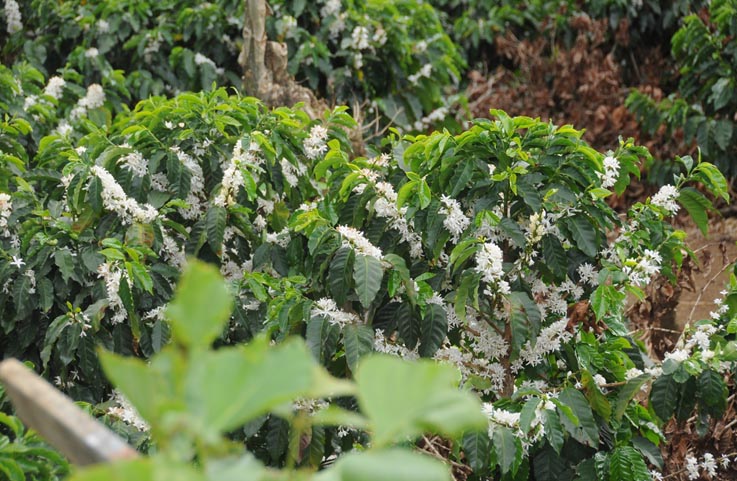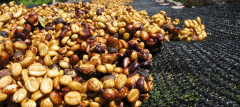Flavor characteristics of coffee producing area information of addis ketema Adis coffee in Yechuefi, Ethiopia

For professional baristas, please follow the coffee workshop (Wechat official account cafe_style)
Ethiopia is the country where coffee was first discovered, and it is still the most important producing country and the best in terms of coffee quality and output. Coffee is mostly traditional Arabica species, with an annual output of about 350000 tons and more than 70% of which are exported to countries around the world. About 15 million people in the country are engaged in coffee-related industries, and more than 90% of the farms or cooperatives are planted in small areas. Crops produced in Ethiopia after 2008, including wheat, corn, sesame and coffee, were fully imported into the ECX trading system (Ethiopian Commodity Exchange) to replace the existing auction and export methods, by coffee farmers or cooperatives to send coffee to ECX centralized warehouses, beans of the same grade and producing areas will be mixed together and auctioned directly. You will not know which farmers or which cooperatives or producing areas produce it. In fact, this practice has no effect on output and quality, and it is easier to tell the quality of coffee by price. What is affected is that intermediate traders cannot freely track their satisfactory profits [low price and high quality] so that consumers are more clear and transparent, because they will be taxed heavily if they do not go through the ECX trading system. Now more than 90% are through this trading system, but for buyers of boutique coffee ECX trading system is not a good thing, so from 2010 Ethiopia launched the DST (Direct Specialty Trade) system, DST system is an irregular Ethiopian auction, only through the SCAA cup test standard of more than 80 points of boutique coffee specialty coffee can hang up their own farm or cooperative name with foreign raw bean traders trade.
The website of DST is http://www.ecx.com.et/DSTIntroduction.aspx.
In Ethiopia, water-washed beans will be distinguished by adding 1 and 2 after the name (with a higher quality of 1). The pulp will be removed immediately after the coffee cherry is harvested, and then the coffee beans will be fermented in water to remove the pectin layer. this process takes several hours, and the number of hours depends on the type of coffee, producing area and temperature, and this process must be closely grasped that if there is a slight mistake, the coffee bean will have a poor flavor. After the fermentation is completed, the coffee beans will be washed through a long sink with high and low drop, and any defective beans and foreign bodies will also be removed during the process. After that, the coffee beans will be dried on the drying bed. At this time, you also need to pay close attention to turning every few hours to ensure the integrity of the drying process. This is the whole process of washing beans.
Addis ketema, the capital of Ethiopia, is the distribution window for coffee, the four major production bases of the Yegashev Coffee Cooperative, and one of the largest coffee growers' organizations in the world, with about 43000 members and 22 basic small cooperatives dedicated to the cultivation of high-quality coffee covering an area of 62000 hectares to ensure the yield and quality of high-quality coffee. Cooperatives are granted special authority to bypass the Ethiopian government. Sell its coffee independently and keep it transparent and open to foreign buyers.
Property Characteristics: farm characteristics
Farmer Farm owner: Various small producers different kinds of small farmers
City City: addis ketema
Region producing area: Gedeo
Grade level: red Cherry Project G2
Country country: Ethiopia
Altitude altitude: 1800-2400m
Farm Size farm area: 10, 000 coffee workers
Coffee Characteristics: coffee characteristics
Variety varieties: local traditional wild varieties of Heirloom
Processing System treatment: Wet-Process washing and drying on scaffolding
Appearance appearance: 16-18 Screen (16-18 mesh)
Top Jury Descriptions comment: the baking degree (Cinnamon) measured by the cup at the beginning of 60 seconds of explosion.
Aroma / flavor flavor: green tea, nutty, jasmine, rose perfume, chamomile, sugar cane, brown sugar
Acidity: fine citric acid, floral acid, mint, cherry fruit acid, lively sour taste
The complexity of complex is similar to that of other: very fresh, flawless, silky and delicate, with a refreshing tea finish.
Overall style attribute: Jasmine fragrant, clean, as thick as silk
Important Notice :
前街咖啡 FrontStreet Coffee has moved to new addredd:
FrontStreet Coffee Address: 315,Donghua East Road,GuangZhou
Tel:020 38364473
- Prev

Colombia-Orange River-St. Augustine Coffee Manor production Information Award record introduction
For the exchange of professional baristas, please follow the coffee workshop (Wechat official account cafe_style) 2009 SCAA Annual Champion of the American Fine Coffee Association Colombia ranks the third largest producer in the world (the first is Brazilian coffee and the second is Vietnamese coffee). Western Colombia is an important producing area of fine coffee in the country. San Augustin St. Augustus flows through the Los Naranjos River.
- Next

The characteristics of Costa Rican honey treatment have an in-depth understanding of white honey, yellow honey, red honey and black honey
Coffee Honey Red Honey processing Costa Rican Honey? Coffee? What's the difference? We all know that all good Costa Rica have one thing in common: extremely pure, extremely soft, extremely balanced and even mellow, so neither high nor low! But this summer, this bean is really extraordinary! Pure and gentle, of course, but the mellow is three layers higher and rich.
Related
- Detailed explanation of Jadeite planting Land in Panamanian Jadeite Manor introduction to the grading system of Jadeite competitive bidding, Red bid, Green bid and Rose Summer
- Story of Coffee planting in Brenka region of Costa Rica Stonehenge Manor anaerobic heavy honey treatment of flavor mouth
- What's on the barrel of Blue Mountain Coffee beans?
- Can American coffee also pull flowers? How to use hot American style to pull out a good-looking pattern?
- Can you make a cold extract with coffee beans? What is the right proportion for cold-extracted coffee formula?
- Indonesian PWN Gold Mandrine Coffee Origin Features Flavor How to Chong? Mandolin coffee is American.
- A brief introduction to the flavor characteristics of Brazilian yellow bourbon coffee beans
- What is the effect of different water quality on the flavor of cold-extracted coffee? What kind of water is best for brewing coffee?
- Why do you think of Rose Summer whenever you mention Panamanian coffee?
- Introduction to the characteristics of authentic blue mountain coffee bean producing areas? What is the CIB Coffee Authority in Jamaica?

